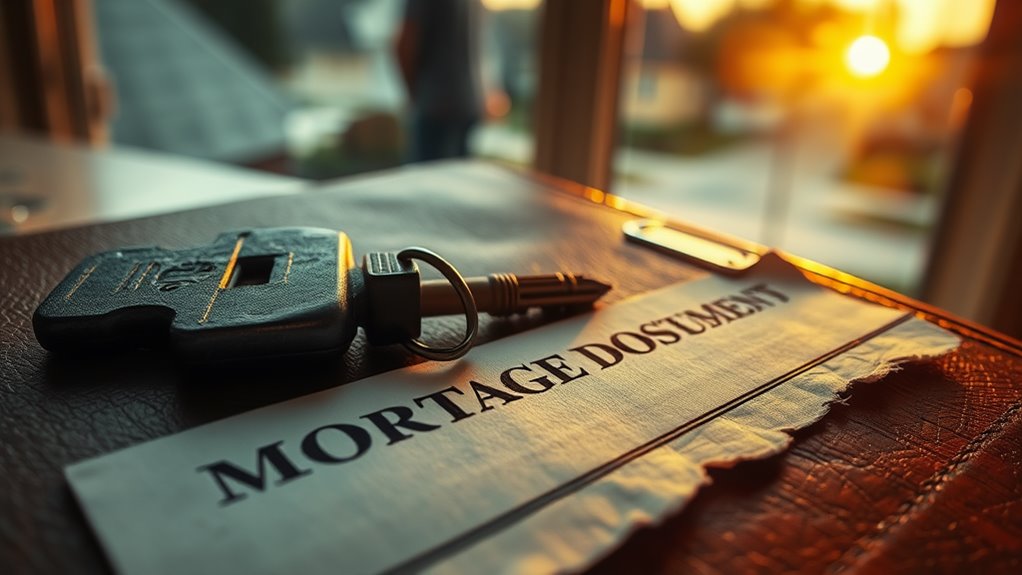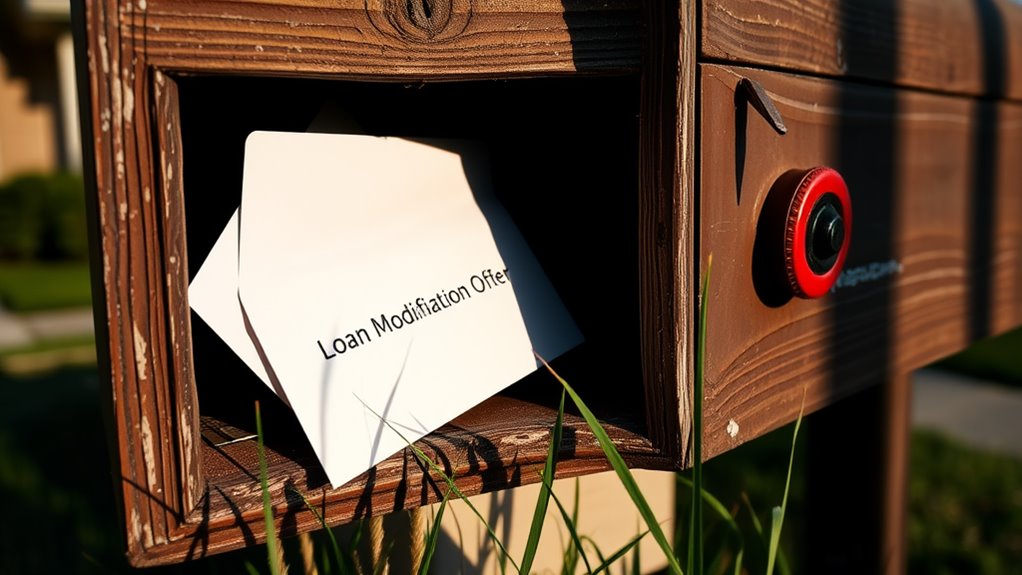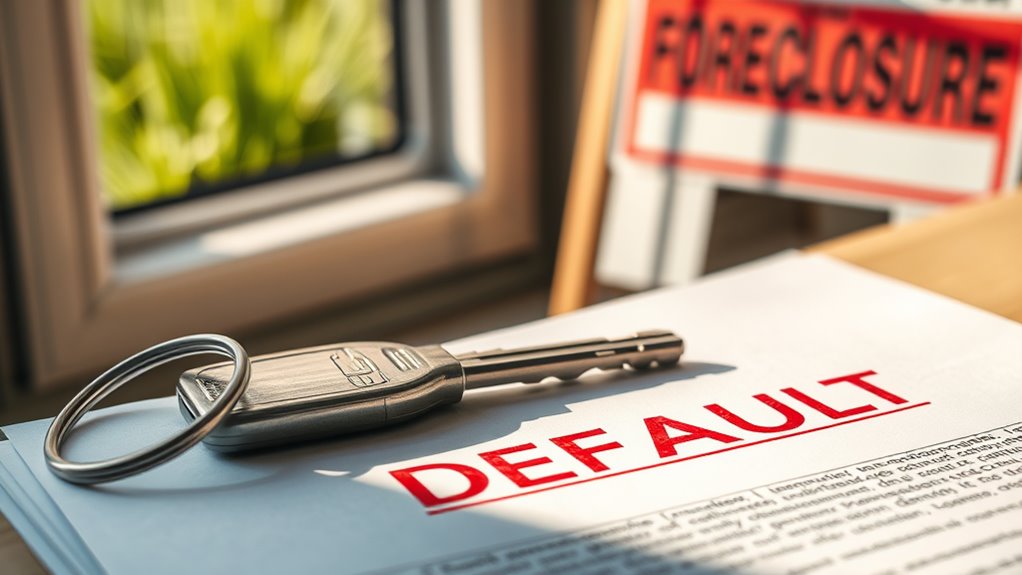Mortgage default occurs when you fail to make scheduled payments on your home loan for at least 30 days. Financial hardships like job loss, medical expenses, or reduced income often cause it. Adjustable-rate mortgages with rising payments or violations of loan terms can also trigger default. Defaulting leads to severe credit damage, foreclosure, and potential legal fees. Understanding your options early can help mitigate these impacts and guide you toward a better financial path.
Key Takeaways
- Mortgage default occurs when payments are missed for 30+ days, violating the loan agreement.
- Financial hardships like job loss or rising payments often cause mortgage default.
- Default triggers credit score drops, foreclosure processes, and potential home repossession.
- Lenders issue default notices; homeowners have legal rights to explore solutions like loan modifications.
- Strategies to avoid default include emergency funds, refinancing, and proactive lender communication.
Definition and Causes of Mortgage Default
When you fail to make scheduled mortgage payments for at least 30 days, you’re considered in mortgage default, which breaches the loan agreement. Default occurs when you’re unable to meet the terms set by the lender, often due to financial hardship such as job loss, unexpected medical expenses, or a significant income reduction. Divorce or other personal crises can also lead to missed payments, disrupting your ability to maintain the loan. Adjustable-rate mortgages with rising payments or economic downturns may increase default risks. Additionally, failure to pay property taxes, homeowners insurance, or unauthorized property transfers can trigger default. Severe property damage or illegal activities on the premises may also violate the loan agreement, leading to default. Understanding these causes helps you recognize potential risks and take proactive steps to address financial challenges before they escalate. Always communicate with your lender if you anticipate payment issues to explore potential solutions such as loan modification or other foreclosure prevention strategies.
Consequences of Defaulting on a Mortgage

Defaulting on a mortgage can severely impact your financial stability and future opportunities. Missing your monthly mortgage payment triggers a series of consequences, starting with a significant drop in your credit score. A default can lower your score by 100 points or more, damaging your credit history and making it harder to qualify for loans or credit. If you fail to resolve the default, your lender will initiate the foreclosure process, which can lead to the lender repossessing your home. During foreclosure, you may incur legal fees and other costs, further straining your finances. The default remains on your credit report for up to seven years, limiting your ability to secure future real estate loans. Additionally, you’ll lose any home equity you’ve built, and foreclosure can delay your ability to buy another property for 2 to 7 years. Exploring loss mitigation options early can help mitigate these risks. In some states, nonjudicial foreclosure may result in a deficiency judgment, allowing lenders to pursue borrowers for the remaining debt if the property sells for less than the mortgage balance.
Legal Rights and Options During Mortgage Default

If you fall behind on mortgage payments, you retain specific legal rights and options to address the default. Your lender must issue a default notice after 30 to 90 days of missed payments, formally alerting you to the delinquency. Federal law grants a 120-day preforeclosure period, during which you can explore solutions before foreclosure proceedings begin. Borrowers rights include requesting a loan modification to adjust payment terms, lower interest rates, or reduce the principal balance. Forbearance agreements may also be available, allowing temporary payment pauses or reductions during financial hardship. Additionally, you can negotiate alternatives like short sales or deeds in lieu of foreclosure, preventing formal foreclosure but requiring lender approval. Proactively engaging with your lender during this period can help you mitigate the consequences of default while preserving your housing stability. Understanding the average default rate of 3.27% can provide context for evaluating risk in similar scenarios.
| Option | Description |
|---|---|
| Default Notice | Formal notification issued after missed payments, detailing the delinquency. |
| Loan Modification | Adjusts loan terms to make payments more manageable. |
| Forbearance Agreements | Temporarily pauses or reduces payments during financial hardship. |
| Short Sales | Sells the property for less than the mortgage balance, with lender approval. |
| Deeds in Lieu | Transfers property ownership to the lender to avoid foreclosure. |
Strategies to Avoid Mortgage Default

Facing challenges with mortgage payments requires proactive steps to prevent default. First, communicate immediately with your lender if you anticipate difficulties; they may offer temporary relief options such as *forbearance*, which pauses or reduces payments. Second, build an *emergency fund* covering three to six months of living expenses to protect against unexpected *financial hardships*. Explore *refinancing* to secure a lower *interest rate* or extend the *repayment period*, reducing your *monthly payments*. Alternatively, request a *loan modification* to adjust your mortgage terms, such as lowering the interest rate or extending the loan duration. Prioritize cutting unnecessary expenses to free up funds for *timely mortgage payments*, avoiding late fees or penalties. Understanding the acceleration clauses in your mortgage agreement can help you prepare for potential consequences of default, ensuring you take necessary measures to prevent it. Taking these measures guarantees you maintain financial stability and prevent mortgage default, safeguarding your home and credit. Always remain proactive and communicate openly with your lender to explore available solutions.
Alternatives to Foreclosure After Default

When mortgage payments become unmanageable, you’ve got options beyond foreclosure that can help protect your financial standing. A short sale allows you to sell your property for less than the mortgage balance, with lender approval, to avoid foreclosure. Alternatively, a deed in lieu of foreclosure enables you to transfer property ownership to the lender voluntarily, halting foreclosure proceedings. Loan modification programs can adjust interest rates, extend loan terms, or reduce principal, making payments more manageable. If you need temporary relief, a forbearance agreement may pause or reduce payments for a set period while you recover financially. Repayment plans are another option, letting you spread missed payments over several months or years to catch up. Each alternative requires lender approval, so it’s crucial to communicate proactively with your mortgage servicer to explore the best solution for your situation. Promissory notes can also be negotiated to outline new terms of repayment, offering flexibility for both parties involved.
Conclusion
If you default on your mortgage, you’ll face severe financial and legal repercussions, including foreclosure. However, theories suggesting default is always irreversible are misleading. You have options, such as loan modifications or short sales, to mitigate consequences. Understanding your legal rights and proactive strategies, like negotiating with lenders, can help you avoid default. While defaulting damages your credit, it doesn’t necessarily mean losing your home if you act decisively and explore alternatives early.




